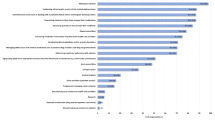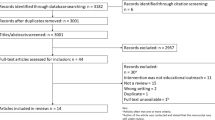Abstract
A producer-independent, problem-oriented, group-education programme with 2-day meetings on drug treatment in primary health care (PHC) was developed and evaluated. Initially, it was tested on a selected group of general practitioners (district physicians), using a non-exposed group as control. A comprehensive questionnaire was used to test changes in attitudes.
There was a significant change in attitudes concerning both general opinions on drugs and drug use, on information about drug treatment, and on use of drugs in selected therapeutic areas. Also, the district physicians became more critical towards information from pharmaceutical companies. Prescribing patterns tended to change in accordance with the attitude changes. Subsequently, the programme was offered to all district physicians (about 550) in the southern Swedish health care region for a 10-year period, with 20–25 district physicians per 2-day meeting. The impact of the programme on the prescribing of a selected group of drugs (antibiotics) was assessed by voluntary registration of prescription by the participants, by regional prescription analyses and by analyses of drug sales data. There were significant, consistent, and sustained changes in the prescribing of antibiotics.
The study supports the view that, if drug prescribing in general practice is to be improved, producer-independent, problem-oriented, face-to-face, small-group education on drug treatment is worthwhile.
Similar content being viewed by others
References
Nordenstam I, Wennberg M, Kristoferson K (1993) Svensk läkemedelsstatistik 1992. (Swedish drug statistics 1992) Apoteksbolaget Farmaceutiska Sektorn, Stockholm
Agenäs I (1990) Distriktsläkarnas andel av recepten (District physicians share of the prescriptions) Allmänmedicin 11:22
Dukes G, Lunde PKM, Melander A, Orme M, Sjöqvist F, Tognoni G, Wesseling H (1990) Clinical pharmacology and primary health care in Europe — a gap to bridge. Eur J Clin Pharmacol 38:315–318
Haynes RB, Davis DA, McKibbon A, Tugwell P (1984) A critical appraisal of the efficacy of continuing medical education. JAMA 251:61–64
Avorn J, Soumerai SB (1983) Improving drug-therapy decisions through educational out-reach. N Engl J Med 308:1457–1463
Schaffner W, Ray WA, Federspiel CF, Miller WO (1983) Improving antibiotic prescribing in office practice. JAMA 250:1728–1732
Ray WA, Schaffner W, Federspiel CF (1985) Persistence of improvement in antibiotic prescribing in office practice. JAMA 253:1774–1776
Ekedahl A, Petersson B-Å, Eklund P, Rametsteiner G, Melander A (1994) Effects on prescription patterns and drug costs of formulary recommendations and information campaigns by community pharmacists. Int J Pharm Pract 2:194–198
Harvey KJ, Stewart R, Hemming M, Naismith N, Moulds RFW (1986) Educational antibiotic advertising. Med J Aust 145:28–32
Denig P, Haaijer-Ruskamp F, Zijsling DH (1990) Impact of a drug bulletin on the knowledge, perception of drug utility, and prescribing behaviour of physicians. DICP, Ann Pharmacother 24:87–93
Mersey Regional Drug Information Service (1983) An assessment of whether the rational and economical use of drugs can be influenced by the Drug Information Service. Mersey Regional Health Authority, Liverpool, JR 124/334
Needham A, Brown M, Freeborn S (1988) Introduction and audit of a general practice antibiotic formulary. J R Coll Gen Pract 38:166–167
Erramouspe J (1989) Impact of education by clinical pharmacist on physician ambulatory care prescribing of generic versus brand-name drugs. DICP, Ann Pharmacother 23:770–773
Newton-Syms FAO, Dawson PH, Cooke J, Feely M, Booth TG, Jerwwod D, Calvert RT (1992) The influence of an academic representative on prescribing by general practitioners. Br J Clin Pharmacol 33:69–73
van de Poel GT, Bruijnzeels MA, van der Does E, Lubsen J (1991) A way of achieving more rational drug prescribing? Int J Pharm Pract 1:45–48
Author information
Authors and Affiliations
Rights and permissions
About this article
Cite this article
Ekedahl, A., Andersson, S.I., Hovelius, B. et al. Drug prescription attitudes and behaviour of general practitioners. Eur J Clin Pharmacol 47, 381–387 (1995). https://doi.org/10.1007/BF00196849
Received:
Accepted:
Issue Date:
DOI: https://doi.org/10.1007/BF00196849




